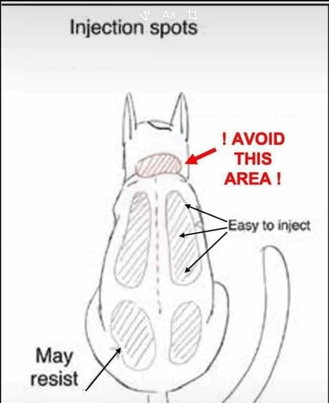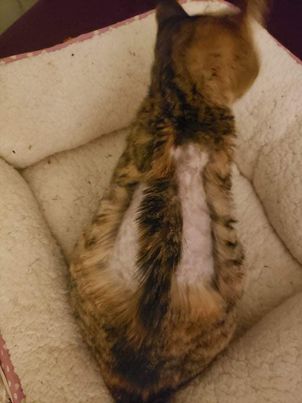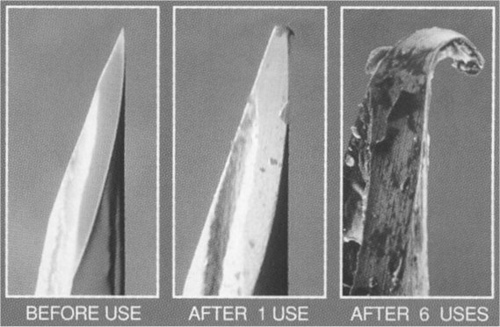

FIP Georgia > treatment info > injections
Here's a diagram showing the recommended areas for the injection, along either side of the spine, and a photo of a kitty who's been shaved in those areas. (Some parents find that if they shave the kitty like that, it's easier to see what they're doing with the injections, and easier to detect and clean up any leakage. Shaving is optional, and totally up to you.) You should rotate among multiple spots in those marked areas, to give each spot time to recover between injections.


See Other supplies for information on needles and syringes. You'll use two needles for each injection: one to draw from the vial, and a fresh one to inject, because the first one will have become dulled when you push it through the rubber stopper on the vial:

It's a subcutaneous injection. If you haven't done those, your vet or vet tech may be willing to give you a lesson. You form a "tent" by pulling up on the skin (or by grasping the base of the fur), then you inject into the open space beneath the skin within the tent, holding the syringe almost parallel to the body, angled slightly downward.
The most common way for an injection to go awry is for the tip of the needle to poke through one of the sides of the tent. It's difficult to see when that's happened, and if you don't notice, when you depress the plunger the solution will all land outside your kitty's body. To prevent that, when you form the tent, pull up firmly, making the skin taut to help the tip of the needle pass through easily, but once just the tip is in, lower the tent partway before inserting the rest of the needle—that will relax and widen the sides of the tent, helping keep the tip inside.
Cats vary in how they react. We recommend beginning with no restraint, and adding restraint only to the extent your kitty demonstrates a need for it.
Some do best with no restraint at all—with those, you can stealthily inject from behind while they're busy eating or otherwise distracted and they barely even notice. Churu purée or similar treats often work great.
One minimal escalation is simply to drape a towel over your kitty's head. Sometimes just not being able to see (or be seen) will relax them and help them feel secure.
Another simple escalation, especially helpful for those doing the injections solo, is to apply a clothespin or "chip clip" to the kitty's scruff. Some parents report that significantly reduces resistance to being injected.
Some kitties will need to be held by one person while another injects. In this video (starting at 2:33), Dr. Uri Burstyn demonstrates several techniques for safely and comfortably immobilizing a kitty ("Squish that cat!"). See also Figures #1-3 on this web page for a secure method of holding a kitty still: with one hand, hold the scruff and tilt the head back, and with the other hand, hold the hind legs (with a finger placed between the legs).
Finally, some kitties do best when restrained in a purrito wrap or grooming bag. Although some kitties become frantic when bagged, others find it soothing. The purrito wrap has a slit providing access to the injection area, and the grooming bag has a zipper that runs along the top and can be opened from either the front or the back. If you're injecting on the kitty's front half, unzip partway from the front; unzip from the back if you're injecting on the back half. There's a velcro enclosure that goes around the neck and will keep the kitty securely in the bag even when the bag is unzipped from the front.
Again, try first with no restraint, and escalate to the other techniques only as your kitty shows them to be necessary. And do your best to remain calm and relaxed—the calmer you are, the calmer your kitty will be.
As treatment progresses and your kitty becomes healthier and stronger, they may resist the injections more vigorously. Many parents find gabapentin, given two to three hours before the injection, helpful to calm the kitty. If you'd like to try that, ask your vet for a sedative-level prescription. (Most kitties are given 75-100 mg.)
Here are some videos demonstrating subcutaneous injections on cats:
The beginning of treatment places demands on the kitty's body (increased heart rate and oxygen flow) that may be challenging if they start out extremely sick. It's very rare, but we have occasionally seen a kitty have a reaction similar to a sugar crash in the hours after one of the initial injections. Please be sure your kitty has eaten before each of their first few injections, and try to have on hand some Karo syrup or a 50/50 sugar/warm water solution, and a heating pad.
A minute or so of vocalizing immediately after each injection, due to the stinging sensation, is normal, as is marked sleepiness in the hours after the first few injections. But if your kitty exhibits any of these signs:
Please remain in close contact with us immediately after your first injection. These complications are, again, very rare, but are dangerous when they occur.
You can try using this dosage calculator, if you like. We can help set it up the first time you use it and provide a special link that will bring up the calculator with the dosage and the medicine concentration already filled in. Then you can just modify the weight as needed, and see the corresponding injection size ("liquid dose").
If you find that comfortable to use, you can do that. And of course you're always welcome to confirm with us, or just report the weight in your treatment chat and ask us to calculate.
FIP Georgia > treatment info > injections